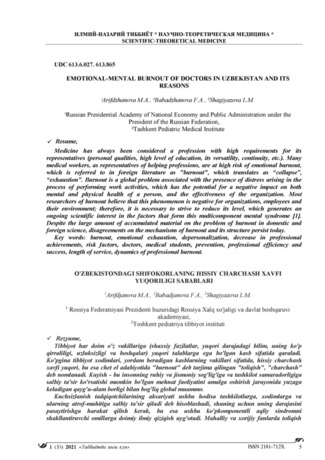




The problem of burnout among medical students
is becoming urgent, because as they move from
teaching through lectures and seminars to clinical
work with patients, focused on helping and caring
for patients, there is an increase in negative
experiences caused by increasing distress, a
decrease in self-confidence and
humanistic
attitudes to the sick. This can lead to a decrease in
the quality of health care provided and negatively
affect the health and well-being of medical students.
Distress during medical school can lead to bumout
with significant consequences, especially if bumout
continues in and out of residency.
Research carried out in 2006 involving different
groups of three medical schools in Minnesota,
found that 45% of students had bumout, in whom
the experience of serious illness was the only
negative life event highly associated with an
increase in bumout. Positive life events were not
associated with burnout, although they were
significantly associated with a lower risk of alcohol
use and depression. The study authors concluded
that their self-reported estimates of the prevalence
of bumout among medical students are limited and
the prevalence of bumout is actually lower. In
addition, the study found that bumout among 1st-
2nd year students was closely related to perceived
levels of support from faculty, while bumout among
3rd and 4th year students was most closely
associated with medical practice, internships and
devaluation of the importance of patients. Patient-
related students on night shifts were more likely to
experience bumout, possibly due to long hours in
the hospital and the severity of practical work
experiences. The frequency of calls, the number of
patients served, appointments and consultations did
not significantly affect the development of burnout
[11].
In our country, a similar, but different situation
is developing: the same internal, external “return”
is important for students, as are the conditions of
study at a medical university, its provision, the
composition of teachers and their professional and
personal qualities, “solidity”, the level of
requirements.
Conclusion
Summarizing all of the above, professional
bumout in doctors is a consequence of complex
interactions:
1)
A subjective assessment of reality: the
quality of education at the university, the prospects
for career growth and personal freedom, material
security, a sense of legal security.
2)
Objective reality: working conditions,
requirements, the adequacy of the authorities, and
1 ( 33) 2021
«Tu66ueinba men K yu»
the ratio of wages to the subsistence level in the
region.
3)
Personal trait, feelings, aspirations.
Moreover, it can develop at different stages of
the formation of a doctor as a professional.
LIST OF REFERENCES
1.
A.L. Zhuravleva, E.A. Sergienko. Stress, bumout,
coping in a modern context / Under. ed. A.L.
Zhuravleva, Moscow: Institute of Psychology, 2011.
512 p.
2.
Chemiss C. Professional burnout in human service
organizations. New York: Praeger, 1980.295 p.
3.
Maslach C., Jackson S., Leiter M. The Maslach
Burnout Inventory Manual (3rd ed.). Palo Alto, CA:
Consulting Psychological Press, 1996.52 p.
4.
Pines E., Maslach K. Workshop on social
psychology: trans. from English SPb Peter, 2003.528
p.
5.
Orel V.E. Mental burnout syndrome. Moscow:
Institute of Psychology, 2005.330 p.
6.
Burisch M. In search of theory: Some ruminations
on the nature and etiology of bumout // Professional
burnout: Recent developments in theory and research
/ W.B. Schaufeli, C. Maslach, T. Marek (eds.).
Philadelphia: Taylor & Francis, 1993. P. 75-93.
7.
Kitaev-Smyk L.A. Burnout of staff. Personal bumout.
Bumout of the soul // Psychopedagogy in law
enforcement agencies. 2008. No. 2 (33). P. 41-50.
8.
Vodopyanova N.E., Starchenkova E.S. Bumout
syndrome: diagnosis and prevention. SPb Peter,
2005.336 p.
9.
Boyko V.V. Bumout syndrome in professional
communication. SPb Peter, 1999.10510. Bakker
A.B., Demerouti E. Job demands- resources theory:
taking stock and looking forward // J. Occup. Health
Psychol. 2016.Vol. 21, N 4. P. 1—14.
11.
Ishak W.W., Nikravesh R., Lederer S. et al. Burnout
in medical students: a systematic review // Clin.
Teach. 2013. Vol.10, N 4. P. 242-245.
12.
Peisah C., Latif E., Wilhelm K., Williams B. Secrets
to psychological success: why older doctors might
have lower psychological distress and bumout than
younger doctors // Aging Mental Health. 2009. Vol.
13, N 2. P. 300-307.
13.
Ishak W.W., Lederer S., Mandili C. et al. Burnout
during residency training: a literature review // J.
Grad. Med. Educ. 2009. Vol. 1, N 2. P. 236-242.
14.
Кощанова, Г. А., Амонова, Н. А., Зияева, Ш. Т.,
Иноятова, Ш. Ш. К., & Хамроев, Ш. Ф. (2016).
Бронхообструктивный синдром: эффективность
различных
вариантов
лечения.
International
scientific review
, (1 (11)), 106-110.
15.
Бабажанова, Ш. Д., А. С. Любчич, and Ю. К.
Джаббарова.
"Факторы,
способствовавшие
неблагоприятному
исходу
при
преэклампсии."
Фундаментальная и клиническая
медицина
6.1 (2021): 27-31.
16.
Абдурахмонова, Н. Х., Ю. К. Джаббарова, and Х.
З.
Турсунов.
"КЛИНИКО-
ПАТОЛОГОАНАТОМИЧЕКИЙ
АНАЛИЗ
ПРИЧИН ПЕРИНАТАЛЬНОЙ СМЕРТНОСТИ
ПРИ
ВРОЖДЕННЫХ
ПОРОКАХ
РАЗВИТИЯ."
Врач-аспирант
43.6.3 (2010): 382-
389.

17.
Аскарьянц, В. П., Х. Х. Ахроров, and Ф. А.
Мустакимова. "Влияние тиреоидных гормонов
на нервную систему."
Medicus
1 (2018): 11-13.
18.
Аскарьянц, Вера Петровна. "Современное
преподавание медико-биологических дисциплин
в медицинском ВУЗе."
Современные научные
исследования и инновации
4 (2016): 502-509.
19.
Tulyaganov, T. S., et al. "NITRARIA KOMAROVII
ALKALOIDS.
VIII.
SYNTHESIS
AND
PHARMACOLOGICAL
PROPERTIES
OF
NITRAMARIN
ALKALOID."
Chemischer
Informationsdienst
16.24 (1985): no-no.
Entered 09.01. 2020
ISSN 2181-712X.
9






